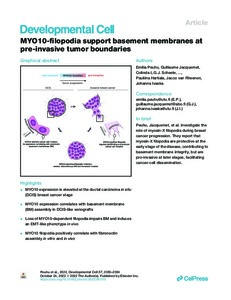MYO10-filopodia support basement membranes at pre-invasive tumor boundaries
Peuhu Emilia; Jacquemet Guillaume; Scheele Colinda LGJ; Isomursu Aleksi; Laisne Marie-Catherine; Koskinen Leena M; Paatero Ilkka; Thol Kerstin; Georgiadou Maria; Guzmán Camilo; Koskinen Satu; Laiho Asta; Elo Laura L; Boström Pia; Hartiala Pauliina; van Rheenen Jacco; Ivaska Johanna
https://urn.fi/URN:NBN:fi-fe2022121371245
Tiivistelmä
Ductal carcinoma in situ (DCIS) is a pre-invasive stage of breast cancer. During invasion, the encapsulating DCIS basement membrane (BM) is compromised, and tumor cells invade the surrounding stroma. The mech-anisms that regulate functional epithelial BMs in vivo are poorly understood. Myosin-X (MYO10) is a filopodia-inducing protein associated with metastasis and poor clinical outcome in invasive breast cancer (IBC). We identify elevated MYO10 expression in human DCIS and IBC, and this suggests links with disease progres-sion. MYO10 promotes filopodia formation and cell invasion in vitro and cancer-cell dissemination from pro-gressively invasive human DCIS xenografts. However, MYO10-depleted xenografts are more invasive. These lesions exhibit compromised BMs, poorly defined borders, and increased cancer-cell dispersal and EMT -marker-positive cells. In addition, cancer spheroids are dependent on MYO10-filopodia to generate a near-continuous extracellular matrix boundary. Thus, MYO10 is protective in early-stage breast cancer, correlating with tumor-limiting BMs, and pro-invasive at later stages, facilitating cancer-cell dissemination.
Kokoelmat
- Rinnakkaistallenteet [27094]
